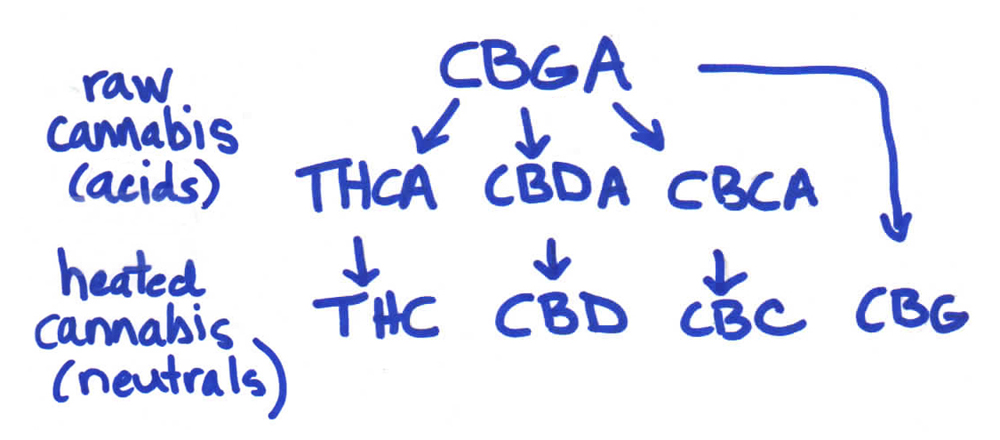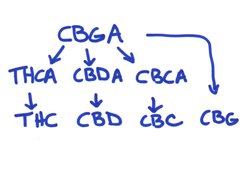When most people think of cannabis as a medicine they are thinking of the cannabinoids THC, CBD and a few others that are getting recent notoriety as new research findings unfold. There is a LOT of information to be found on these substances and more and more is being discovered everyday. Cannabinoids help moderate our body’s own endocannabinoid system, (ECS) which in turn mediates many human illnesses and conditions. CB1 & CB2 receptors throughout our bodies are accessed by cannabinoids our bodies produce on their own as well as the cannabinoids in cannabis products. All this is known. But, are CB1 and CB2 receptors the ONLY receptors in our body that are affected by cannabis? Absolutely not! It’s NOT all about the endocannabinoid system.
In my last post, What good is THCa, or why does gramma feel so good?, I pondered why I’ve felt so much better over the last few months and if my last batch of canna caps are the reason. When I made my cannabis oil I left out a seemingly vital step in the process – decarboxylation*. Was this new batch of oil – rich in THCA but very low on THC – the reason I felt so good? Researching this proved to be harder than I thought. The information is difficult to find.
Not long after the last post went live, I saw a link to a web site that claimed that only decarboxylated cannabinoids can bind with our cannabinoid receptors, thereby giving us the desired therapeutic effect. Ok, but then how is it that my home made FECO (full extract cannabis oil), was working better than any high THC oil I’ve purchased in the past, and why does raw cannabis, (also sans the activated neutrals THC and CBD), also work very well for so many people? These products contain little to no THC or CBD! How was our body processing the cannabinoids acids if not through the endocannabinoid system? I needed more information.
“…d9-THC and CBD (two neutral cannabinoids) are much better analgesics, so they are best for acute pain, NOT chronic pain. Anti-inflammatories, like cannabinoid acids, are better in the treatment of chronic pain.”.
I’m not a medical professional. Certifications in Reiki and Aromatherapy are the closest I come to the healing arts besides helping my daughter study for nursing school and what I read on my own. I dug deep into my library and the internet and could not find any answers as to why my medicine was working for me. I finally turned to the man who first made me aware that the unactivated THC and CBD acids – THCA and CBDA – were indeed good medicine. Rev. Dr. Kymron deCesare, of Steep Hills Lab was very responsive to my plight, and rather than paraphrase what he told me, I’ll share it exactly, with his permission:
“Terpenoids (including cannabinoids) are active in a wide variety of receptors other than just the CB receptors of the Endocannabinoid System (ECS). Along with CB receptors, they are active in PPAR, PGR2, COX pathways, TRPV receptors, etc etc. It is pure ignorance to think that ONLY d9-THC works, and ONLY in ECS receptors.
In this case [my case – Rheumatoid Arthritis, Severe Osteoarthritis, Fibromyalsia], THCa is actively working in the COX1 and COX2 (which are mainly steroid pathways), which is why your pain from RA is greatly reduced by it.
Normally 1 gram of a “top shelf” flower contains about 200mg of THCa. Normal dosage is upwards of 100mg, once or twice daily, so 1/2 gram of high quality flowers contains 100mg.
Minimal pain relief comes after 12 hours. Major pain relief develops over about 7-14 days.
For the record, d9-THC and CBD (two neutral cannabinoids) are much better analgesics, so they are best for acute pain, NOT chronic pain. Anti-inflammatories, like cannabinoid acids, are better in the treatment of chronic pain.”

Thank you, Rev. Dr. Kymron! What a great answer. This is HUGE folks. Until about 20 years ago when it was discovered that a chemotherapy drug called methotrexate was useful in suppressing the immune system of people with auto immune diseases, the only thing that could be offered to these patients was typical NSAIDs (non steroidal anti-inflammatory drugs like aspirin and ibuprofen), or steroids that do more harm than good in the long run. Then Big Pharma came up with the latest round of drugs call biologics, like Humira, Enbrel and Remicade which are essentially genetically engineered proteins from human genes.
Enter cannabis research, and if this had been done years ago we may have been able to skip theses side effect laden, life threatening pharmaceuticals that are being so heavily prescribed today.
* decarboxylation is the heating of cannabis, either by smoking or vaporizing dry cannabis, or by heating the plant material before using in a edible or topical application. This converts the acid forms of the cannabinoids into neutral form. For more info read “Decarb Myths Debunked”.
For those of you who want something a little more technical I offer some definitions/explanations of the receptors and pathways that Rev. Dr. Kymron is speaking of:
PGR2 – GPR142 Probable G-protein coupled receptor 142, protein also known as: G-protein coupled receptor PGR2. Exclusively expressed in the central nervous system, most abundantly in the ventrolateral region of caudate putamen, the habenular nucleus, the zona incerta, and the medial mammillary nucleus. (Gene proteins? Who da thought? This one is way beyond my true understanding, but the medical folks will get it. Even my feeble knowledge of medicine can see a connection between what these made-made pharmaceuticals do and what they are discovering that cannabis may do even better, and safer.)
COX (1&2) Cyclooxygenase (COX), the key enzyme required for the conversion of arachidonic acid to prostaglandins. Despite the wide use of NSAIDs over the last century, their mechanism of action was not fully appreciated until 1971, when Vane published his seminal observations proposing that the ability of NSAIDs to suppress inflammation rests primarily on their ability to inhibit the cyclooxygenase (COX) enzyme (1). This would limit the production of proinflammatory prostaglandins (PGs) at a site of injury. Given this, NSAIDs have been used by scientists for the last 25 years to dissect the critical role that both the COX enzyme and the eicosanoids derived from this pathway have in normal and abnormal physiologic states.
These include prophylaxis against cardiovascular disease, relief of the discomfort associated with minor injuries and headaches, and alleviation of the severe pain caused by a variety of inflammatory and degenerative joint diseases.
TRPC Transient receptor potential channels (TRP channels) are a group of ion channels located mostly on the plasma membrane of numerous animal cell types. Many of these channels mediate a variety of sensations like the sensations of pain, hotness, warmth or coldness, different kinds of tastes, pressure, and vision. (These channels are really interesting in what they moderate in your body, so I would look further at these and see what they can do for you and your condition.)

How do I make a paste from the liquid? I want to add coconut oil because the alcohol will dry out my skin. Also do I boil the liquid first. ?
You can warm up any kind of oil or fat (ie: coconut oil, olive oil, shea butter etc.), in a hot water bath or in the microwave, and add/mix into it a concentrated cannabis oil. Coconut oil will solidify again when it cools, so it is a very simple choice to make a salve.
Great article Sarijuana! Definitely worth a shot! I can always make a small batch and see how it goes! Thanks!